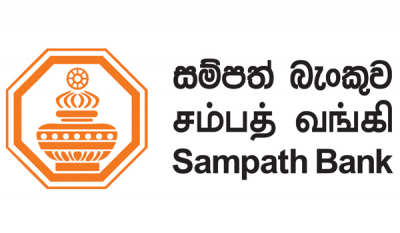Sampath Bank's 429 ATMs, 448 Deposit Kiosk Machines (DKMs) and all 229 Branches when permitted remained fully operational during the entire period of lockdown, enabling customers to perform routine transactions with the Bank.
Our ongoing investments in digital technology continued to benefit customers during this hour of need, shown by the extensive use of Sampath Vishwa - the Bank's digital platform.
Sampath Vishwa proved to be a convenient and efficient alternative mode of payment right throughout this period.
The spread of COVID-19 comes just as the Country's economy seemed to be slowly recovering from the spillover effects of the Easter Sunday terror attacks in April 2019.
However, as it stands now, the impact of the economic downturn cannot be estimated.
It is noteworthy that while Sri Lanka appears to have managed the COVID-19 outbreak reasonably well, the obvious economic fallout from the local and global lockdown will be unprecedented.
It has affected supply chains significantly and the cascading effect will severely impact almost all businesses in the country.
Amidst this backdrop, Sampath Bank remains committed to support all stakeholders to overcome this unfortunate situation.
The Bank has already put in place all necessary systems and processes to facilitate relief under various schemes announced by the Government.
The Bank is now equipped to accommodate the debt moratorium, grant working capital loans at concessionary rates and support new investments through loans for eligible individuals and ventures.
Impact of COVID-19 on the Banking Industry
Due to the unsettled economic environment, the prospects for Sri Lanka's Banking sector in 2020 remains bleak.
While government mandated credit concessions are expected to decrease the impact on individuals and businesses, it would certainly impact liquidity, revenue growth, credit growth and credit quality of all Banks in the country.
Further, profitability will be severely compromised.
On a positive note, the Central Bank of Sri Lanka (CBSL) has relaxed certain rules and regulations to provide space for banks to assist COVID – 19 affected businesses.
These include lower capital conservation buffers, relaxed non-performing classification rules, decreased SRR, changes in restructuring loan classifications and extension to address supervisory concerns.
In addition, the Institute of Chartered Accountants of Sri Lanka (CASL) has issued a guidance note suggesting measures that can be adopted to soften the immediate impact on financial reporting due to this global disaster.
Future of the Bank
Sampath Bank will adopt a broad-based approach that includes sound strategic planning coupled with effective management decisions to overcome the prevailing challenges.
The Management team of the Bank will remain vigilant in managing assets and liabilities and meeting all contractual obligations of the Bank while ensuring delivery of all concessions to customers and other stakeholders.
All ongoing projects and recent proposals will be re-evaluated with a view to redirecting expenditure only to essential core business requirements.
At the same time, the Bank will cautiously explore new business opportunities that may present itself from time to time.
In this regard the Bank will seek to upgrade the skills of employees and invest in technology where necessary in order to leverage on such opportunities successfully.
Furthermore, it is expected that Sampath Bank's solid fundamentals including a strong capital base, expertise in IT and the capacity of Team Sampath will help strengthen resilience and support the Bank to perform consistently in the medium to long-run despite the current economic distress.
Financial results of Sampath Bank for the first quarter of 2020: Operating profit before all taxes down by 10.8% while there is a moderate growth in PAT due to withdrawal of DRL & NBT
The challenges brought by COVID – 19 pandemic and the recession brought on by the terrorist attack in April 2019 has lead the period under review to be pressurized by some unique challenges that were not seen in Q1 2019.
Therefore, it is important to note that comparing the results of Q1 2020 with the corresponding period in 2019 may not be realistic.
Operating profit before all taxes, which is the real return generated by utilizing the assets and liabilities of the Bank, declined by 10.8%.
This decline was due to the reasons mentioned above. Sampath Bank recorded a Profit before tax (PBT) of Rs 3 Bn for the quarter ending 31st March 2020.
The Bank reported Profit after tax (PAT) of Rs 2.5 Bn for the three months ended 31st March 2020, reflecting a growth of 15.7% over the corresponding period in 2019.
PAT growth was attributed to two factors; (1) the higher exchange income due to depreciation of the Sri Lankan rupee against the US dollar by Rs 7.90 during the quarter and (2) tax concessions received owing to the abolition of Debt Repayment Levy and NBT on financial services.
Meanwhile, the Sampath Group achieved a PBT of Rs 3.3 Bn and a PAT of Rs 2.7 Bn for the period under review compared to Rs 2.8 Bn and Rs 2.1 Bn reported in the corresponding period of 2019.
Fund Based Income (FBI)
Owing to the prevailing challenges, average weighted prime lending rate in the Country dropped by approximately 3%.
A similar drop was observed in Treasury Bill interest rates.
Consequently, Sampath Bank's Net Interest Income (NII) decreased by Rs 0.2 Bn to Rs 9.98 Bn as at 31st March 2020, a decline of 2.4% compared to the figure reported in Q1 2019.
It should however be noted that despite the challenging conditions, effective fund management strategies helped to restrict the decline in NII to 2.4%.
The Bank will monitor the NII continuously and will implement appropriate actions to safeguard the NII to the best of its ability in the future.
Overall, interest income for the period under review decreased by Rs 1.1 Bn and stood at Rs 24.5 Bn compared to Rs 25.6 Bn recorded in the corresponding period in 2019, a decline of 4.3%.
Interest expenses for the period under review decreased by 5.5%.
For the three months ended 31st March 2020, Sampath Bank registered interest expenses of Rs 14.5 Bn compared to Rs 15.4 Bn recorded in 2019.
As a result, the Net Interest Margin for Q1 2020 decreased to 4.13% compared to 4.46% reported in 2019.
Non-Fund Based Income (NFBI)
Net fee and commission income, which largely comprises credit, trade, card, and electronic channel related fees, was Rs 2.2 Bn for the quarter under review, a marginal decline of 1.4% over the figure reported in Q1 2019.
The decline was kept to a minimum due to the strong market attractions for innovative value additions offered through electronic channels and was further enhanced due to the higher usage volume of electronic channels during the lockdown in March 2020.
Net other operating income recorded a YoY increase of 321.6% in Q1 2020, led mainly by an increase in realized exchange income due to a 4.4% depreciation of the Sri Lankan Rupee against the US Dollar.
Consequently, net other operating income for the first three months of 2020 increased to Rs 2.3 Bn, from the loss of Rs 1 Bn reported during the corresponding period in 2019.
On the other hand, the Bank incurred a net trading loss of Rs 664 Mn as a result of mark to the market losses on forward exchange contracts owing to the aforementioned currency depreciation.
Therefore, the Bank's net exchange income from foreign exchange transactions amounted to Rs 1.6 Bn for the period under review.
Operating Expenses
The Bank’s total operating expenses, which amounted to Rs 5.14 Bn in 1Q 2019, increased marginally by 0.2% during the period under review to Rs 5.15 Bn in 1Q 2020.
The increase in operating expenses was kept to a minimum, thanks to comprehensive cost containment strategies implemented throughout the period under review.
Consequently, the Bank's cost-to-income ratio, excluding taxes on financial services was 37.1% at the end of 31st March 2020, significantly lower than the 39.6% reported for the corresponding period in 2019.
Impairment charges
Due to lack of reasonable and reliable information with regard to the impact of COVID - 19 on its customers as at the reporting date, the Bank has taken into consideration the long-term economic trends as the basis of calculating impairment provisions for the quarter.
Further, the Bank has also considered the relief packages introduced in the form of tax reliefs and moratoriums by the government to protect the economy.
It is noteworthy to mention that the Bank has made a substantial provision as management overlays by changing the probability weights applied to different macro-economic scenarios.
This revision together with increasing non-performing loans resulted in higher impairment charges for the period under review.
The total impairment charge for the first three months ended 31st March 2020 was Rs 4.9 Bn compared to Rs 3.5 Bn recorded in 1Q 2019 denoting an increase of 39.7%.
The gross non-performing loans increased to 6.72% at end of 31st March 2020 from 6.37% reported at the end of 2019.
Business growth
Sampath Bank’s total asset base grew by 2.2% (annualized 8.7%) during the period under review to reach Rs 983 Bn as at 31st March 2020.
In comparison, the total asset position as at 31st December 2019 stood at Rs 962 Bn.
Gross loans & advances grew by 3.4% (annualized 13.9%) to reach Rs 744 Bn as at 31st March 2020, recording a growth of Rs 24.8 Bn for the period under review.
The total deposit base increased by Rs 31.1 Bn for the same period, to reach Rs 749 Bn as at the reporting date, a growth of 4.3% (annualized 17.4%).
Meanwhile, the CASA ratio stood at 35.6% at the end of the reporting period.
Capital adequacy and performance ratios
The Bank’s Common Equity Tier (CET) I Capital, Tier I Capital and Total Capital Adequacy ratios as at 31st March 2020 stood at 13.65%, 13.65% and 17.16% respectively, all well above the corresponding minimum regulatory requirement of 6.5%, 8% and 12%, applicable as at the reporting date.
CBSL reduced the Capital Conservation Buffer by 0.5% with effect from 27th March 2020.
The Statutory Liquid Asset Ratio (SLAR) for the Domestic Banking Unit and the Off-Shore Banking Unit was at 22.18% and 31.05% respectively as at the reporting date, while Return on Average Assets (ROA) (before tax) stood at 1.26% and Return on Average Equity (ROE) (after tax) stood at 9.47% at the end of 31st March 2020.






















